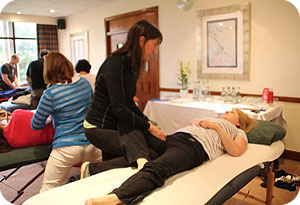A therapist asked me to name the five books that had brought me to be the therapist I am today……..thought of the five. However there are  really six each in their own way shaped and guided my offering all kind of information to challenge, educate, create more question and promote at time deep reflection. The reflection was who I am as a therapist, my intent and compassion.
really six each in their own way shaped and guided my offering all kind of information to challenge, educate, create more question and promote at time deep reflection. The reflection was who I am as a therapist, my intent and compassion.
All equipping with differing skills to treat people with chronic long term pain and those sport injuries that have been persistent, as well as those acute condition we see each week.
Thomas Hendrickson, Massage and Manual Therapy for Orthopedic Conditions, Second Edition, (Lippincott Williams & Wilkins), 2009 and his accompanying DVD
Tom’s book came a long when as a massage therapist I was looking for a technique that would enable me to become increasingly precise, deep yet gentle and one that wasn’t going to create a secondary inflammatory response. I had also begun to notice a torsion in the fibres of injured muscle and had begun to develop my own strokes through my oil work to role muscle away from the mid-line of the body. THEN I found Tom’s book, decades ahead of me! His book was reassuring, it gave the precise movements I had been searching for, that at last I was truly working with the body and not at the body. His explanation of Muscle Energy Technique was so much more accessible. So I study it, then had to go meet him. Through Tom’s patience and guidance, aided by his assistants I connected with his wave mobilisation, learning to trust my own body much more. Those who have trained in the Hendrickson Method say, ‘phew there are no more scary patient’ because the HM encourages you to be very proficient in your anatomy knowledge. This then creates a more refined understanding when addressing subjective and objective assessment.
Nicola J Petty, and Ann P Moore, Neuromusculoskeletal Examination and Assessment, Second Edition, (Harcourt Publishers Ltd.), 1999, 2001
This book helped me to understand assessment much clearer, I had a stronger grasp of how much deeper subjective assessment needed to be. To get that big picture of your patients history, clues that guide you down the most useful path for your patient. Especially those patients with long term chronic pain. Some of the objective movement are extreme but can be useful when you think you might have missed something.
Nancy C. Cutter, and C. George Kevorkian, Handbook of Manual Testing, (The McGraw-Hill Companies, Inc.), 1999
This book is so easy to access, each page gives you the open and closed chain action, nerve innervation, antagonist, synergist, and a little test for function. I have it on my desk even now, just to check up if I am wondering ‘have I remembered that ‘
It is also really useful to show the patient which muscles that I am working and why!!……..they really find it useful
Explain pain, course Neuro Othopaedic Institute uk
This book answered all sorts of question I was developing re my long term pain patients. That less is more, that patients need to find the right therapist at the right time with the right therapy, that the body only create pain when it feels under threat. Wonderful illustrations to help with explaining to patients and amazing workshops which may need visiting twice, for all the information to sink in.
Joseph O’Connor and Ian McDermott, Principles of NLP (Singing Dragon)
In 2003 I embarked on an NLP practitioner programme, I felt the way forward was to increase my communications skill. Having tried a few different methods but NLP seemed sensible, it had a process not unlike what I did each day in my treatment room. It was life changing, both for me and my patients. I was often caught up in trying to fix everything for my patients, mind body and soul, and exhausting myself.
PPD Learning lead by Judith Lowe, the process helped me to see my patterns of behaviour. What pay back I got from them and were they useful! After a period of soul searching, I developed a greater understanding. It was in brief giving people the space that is useful for them, for them to sort it out! Phew.
I would recommend training with Judith Lowe, she is a clear, clean, emphatic teacher with a cracking sense of humour and passion for subject
This little book above sums it all up very easily and accessible for someone new to NLP.
Erik Franklin, Dynamic Alignment Through Imagery 2nd Edition (Human Kinetics)
This is my latest addition. I wanted a book that would explain movement, that would be meaning full for both myself and patients. He explains movement in a way that I can connect with as a visual learner. Also his little movements with visualisations to give to my patients really do work and they do get their homework done, and progression is made.

 On the weekend of the 16th and 17th of May, Hendrickson Method Practitioners and those embarking on the work, all of whom have attend an Introduction to the Hendrickson Method gathered.
On the weekend of the 16th and 17th of May, Hendrickson Method Practitioners and those embarking on the work, all of whom have attend an Introduction to the Hendrickson Method gathered. My last two blogs have been in relation to subjective & objective assessment. It feels right to have a closer look at the ‘planning’ stage of treatment plans.
My last two blogs have been in relation to subjective & objective assessment. It feels right to have a closer look at the ‘planning’ stage of treatment plans. All the books below lay out clear protocols for objective assessment – active, passive, resistive. These are often full range movements, so the question that often comes up at the workshops is “How do we discover the cause, when people are too much in pain to move!”
All the books below lay out clear protocols for objective assessment – active, passive, resistive. These are often full range movements, so the question that often comes up at the workshops is “How do we discover the cause, when people are too much in pain to move!”